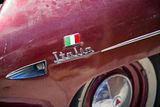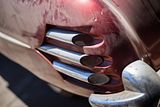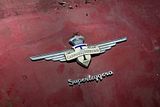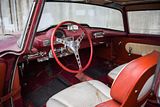Another American grand-tourer with Continental flair – the 1955 Hudson ItaliaHemmings Daily News, Kurt Ernst Jul 29th, 2015 Chrysler’s relationship with Italian design firm Ghia brought it a fair amount of time in the spotlight, a fact that did not go unnoticed by rival automaker Hudson. Fresh from the success of the Hudson Hornet in NASCAR, and looking for a way to market its new-for-1953 Jet compact, Hudson contracted with Italy’s Carrozzeria Touring on a Jet-based grand tourer, ultimately called the Italia. Counting the initial prototype, 26 were reportedly built, and next month the second-to-last production example, chassis IT10024, will roll across the auction stage in California. The Hudson Italia was designed by Frank Spring, Hudson’s chief stylist, and Carlo Felice Bianchi Anderloni, his counterpart at Carrozzeria Touring. The Italia project was a consolation prize for Spring; his initial design for the Hudson Jet was so radically altered by the time the car hit production that Spring threatened to quit. To pacify him, Hudson management dangled the carrot of a concept sports car, something that Spring had long pestered the company’s management to build. Designing an all-new model from the ground up was deemed cost-prohibitive, so it was Spring who made the initial contact with Touring. Production Hudson Jets were shipped to Touring in Milan, where the steel body was replaced with a superleggera body of hand-formed aluminum over a frame of thin-wall steel tubing. To call the design radical is a bit of an understatement, and the Italia sported triangular fender vents above the front wheels (presumably to aid in brake cooling, though these vents were not ducted), triangular bumper adornment, a wrap-around windshield and faux “exhausts” in the rear fenders that held taillamps, directional and stop lamps. Inside, the Italia’s most unique feature was its two-passenger Mid-Century Modern seating. Each front bucket utilized a relatively conventional seat bottom, coupled with a twin-cushion upper that used foams of different density in each pad for added comfort. The gap between the cushions was intentional, and allowed the seats to “breathe” for added passenger comfort. One departure from convention was the use of leather seat belts, which were optimistically mounted to the seats themselves instead of a stronger and more rigid structure. Though the Italia presented a more sporting appearance than the Jet, it was offered only with that model’s 202-cu.in. L-head six-cylinder engine, topped by a two-barrel Carter carburetor and rated at 114 horsepower. The sole transmission offering was a column-mounted three speed, but despite this, Hudson reportedly had plans to run the car in the touring car class at the La Carrera Panamericana. Doing so would require a run of 25 cars for homologation purposes, so Hudson contracted with Touring for an additional 25 cars after the initial prototype was completed. The Italia proved to be a tough sell, and not just because of its unconventional styling. Despite cheaper labor, the expense of building the car in Italy raised the manufacturing cost, prompting Hudson to slap an F.O.B. Detroit dealer price of $4,800 on the coupe. In 1955, that was nearly double the retail price of a Ford Thunderbird, $1,866 more than a Chevrolet Corvette and $1,132 more than a Kaiser Darrin. In fact, it was even $495 more than a Cadillac Coupe de Ville, limiting the Italia’s appeal to a select group of well-heeled buyers; reportedly, just 19 Hudson dealers agreed to purchase Italias, leading to some confusion on the actual number built, shipped or sold in North America. When American Motors merged with Hudson in 1954, it soon became apparent that the Italia program had reached its end. Perhaps angered by the loss of future business, Touring refused to manufacture or distribute spare parts, leaving potential Italia buyers to source comparable replacements on their own in the event of body damage. he early history of chassis IT10024 is a bit hazy, but by the end of the 1950s the coupe had been acquired by UFO researcher Trevor Constable. It’s not clear how long Constable owned the car, but during his stewardship, a rear window wiper, fog lamps and Italian flag badging were added. At some point during the car’s history, possibly under Constable’s time with the car, the six-cylinder Hudson engine and three-speed transmission were pulled, replaced by a 283-cu.in. Chevrolet V-8 coupled to a four-speed, floor-shift manual transmission, though this drivetrain would also go missing. Sometime in the early to mid-1970s, chassis IT10024 was acquired by collector Carl Mendoza, who parked the car (minus its driveline) in a San Jose garage. It would remain there for the next four decades, the property changing hands and the car eventually changing owners by default. As offered, the car remains without engine or transmission, though sourcing a Hudson straight-six and three-speed transmission should not prove especially problematic for the Italia’s buyer. Gooding & Company anticipates a selling price between $100,000 and $125,000 when the car crosses the auction stage at Pebble Beach. For additional information on the company’s California sale, visit GoodingCo.com. |
|









